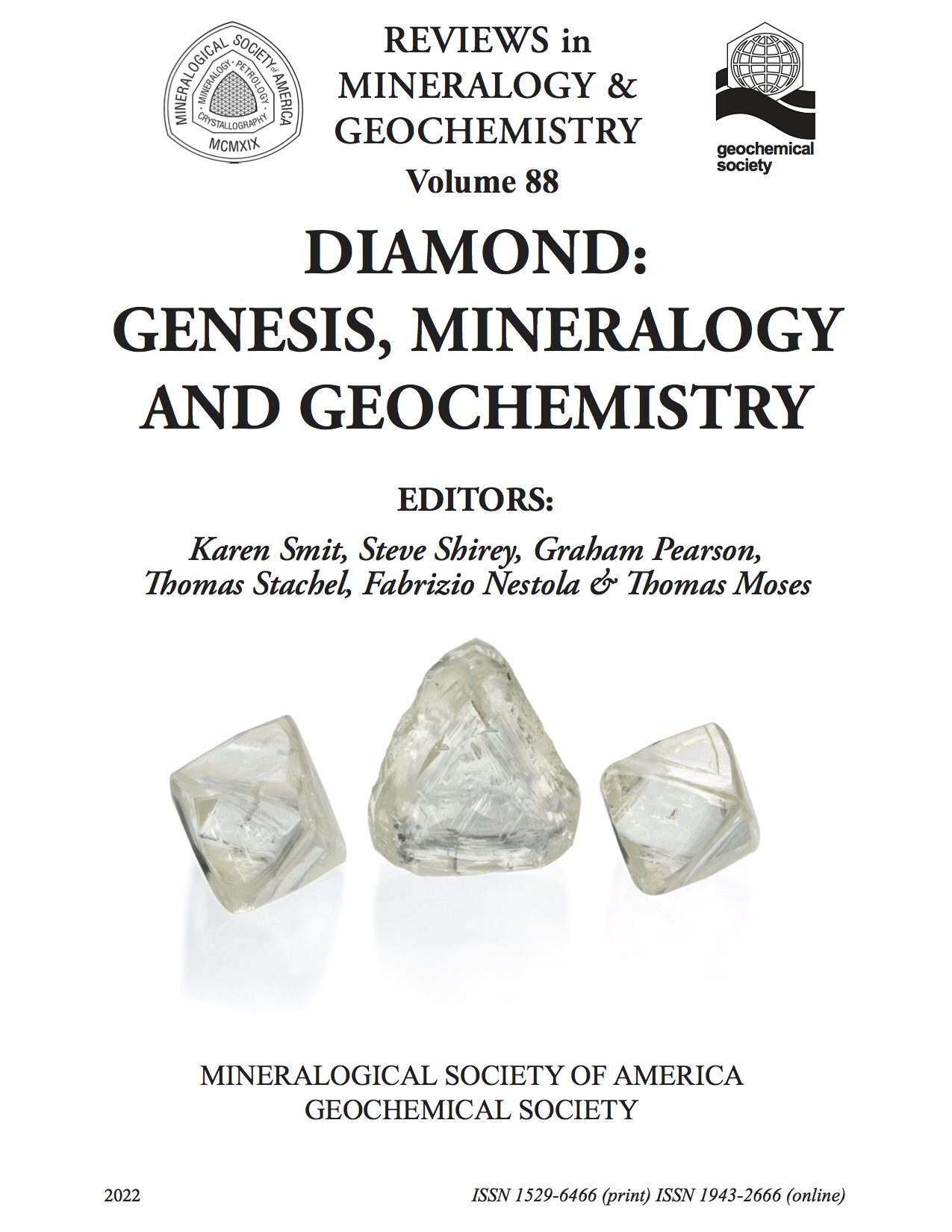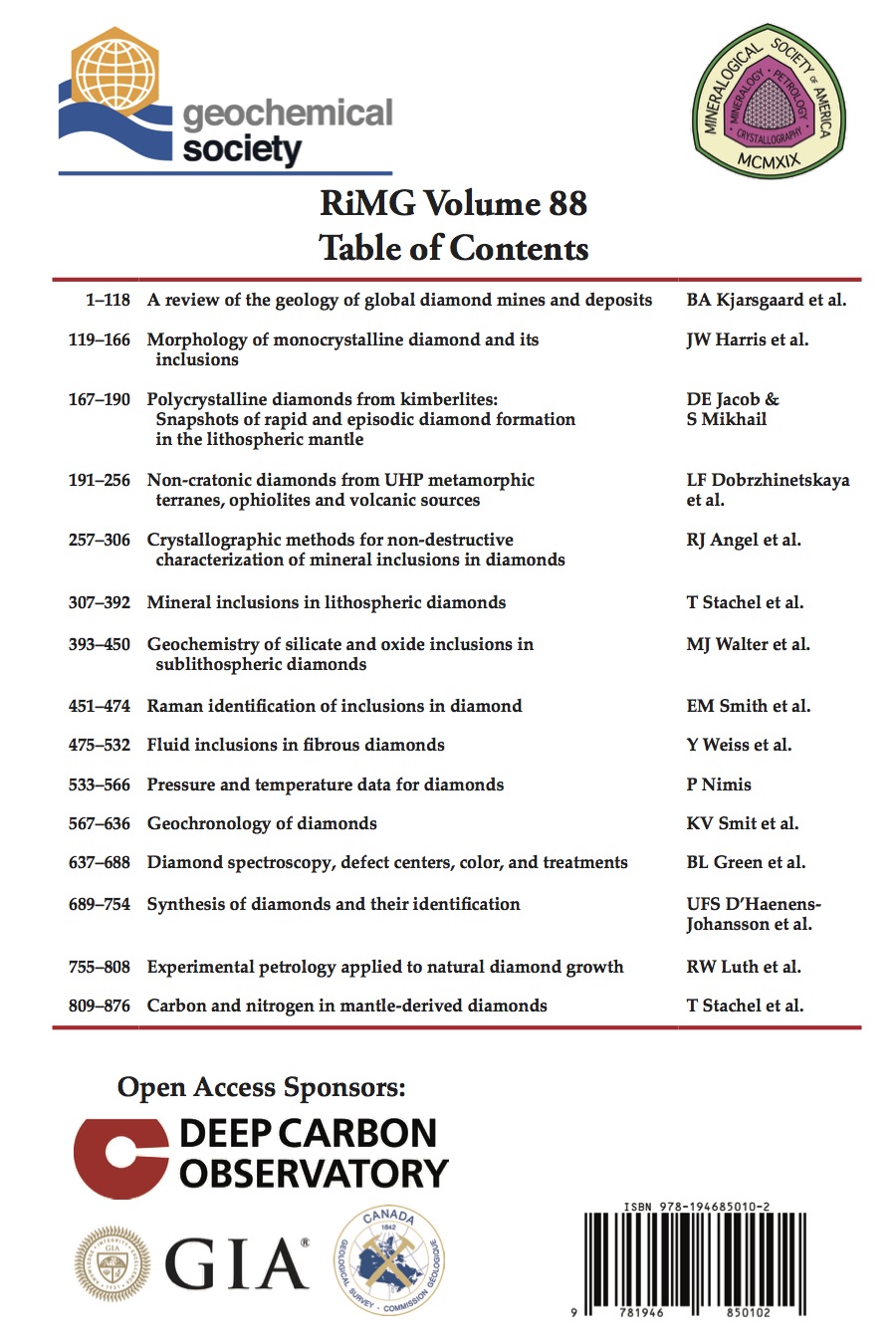

Mineralogical Society of America, Founded December 30, 1919
Subscriber Access MinPubs.org Pay-Per-View
Order Publications Online (25% discount for MSA, CMS and GS members, except shipping)


2022, i-xvi + 876 pages. ISBN 978-1-946850-10-2
From the Preface to the volume:
After more than 80 volumes of Reviews in Mineralogy and Geochemistry (RiMG), we now have a volume on diamond—Diamond: Genesis, Mineralogy and Geochemistry. Diamond is the record-setter in many mineralogical properties such as hardness, diffusivity, thermal conductivity, purity, and covalency of bonding. Similarly, diamond, as the premier gemstone of the mantle holds primacy for geological features such as age and depth of origin. Diamond was among the first crystalline structures to be solved by X-ray diffraction and the first materials measured for their Raman spectrum. Despite its chemical simplicity, diamond has been the object of more research effort, and had more scientific and popular press pages written about it, than any other mineral.
After more than half a century, geologists now thoroughly understand many aspects of the mantle-convection-driven process of plate tectonics. This understanding is an essential backdrop to understanding how diamond forms because diamond is the only mantle gem to be directly created by plate tectonics, wherever its carbon has been derived. Over the same half century, many analytical techniques such as mass spectrometry (SIMS, TIMS, LA-ICP-MS), spectroscopy (Raman, IR), microanalysis and sampling (EPMA, STXM, TEM, FIB, XRD) have developed such improved sensitivity and spatial resolution that they now can handle the purity and minute lattice imperfections in diamond and allow the study of its very tiny mineral and fluid inclusions. Similarly, advances in the size, depth, and pressure attainable by experimental apparatus such as piston cylinder, multi-anvil and diamond anvil presses have reproduced and mapped the stability of the mineral inclusions trapped in the diamond structure to reveal the P,T conditions of diamond formation and to allow stringent constraints to be placed on the mineralogy of the mantle host rocks.
The purpose and goal of this new volume is to assemble all the chief current knowledge about natural diamond in one body for the use of the Earth Science community. The contents of this volume are wide-ranging with the goal to leave little out so that any scientist could reach for this volume to obtain as much basic diamond knowledge as necessary. An important feature of Diamond: Genesis, Mineralogy and Geochemistry is that the authors of several chapters used new and up-to-date databases that were expressly compiled for the purposes of accuracy in writing their chapters. These databases are available for community use at: https://dataverse.scholarsportal.info/dataverse/diamond.
Reviewers, beyond the editorial team, worked hard to improve the quality of these long chapters. Our thanks go to Mike Ashfold, Gerhard Brey, Ingrid Chinn, Phil Diggle, Wali Faryad, Yana Fedortchouk, Boris Feygelson, Andrea Giuliani, Jon Goss, Herman Grutter, Ben Harte, Peter Heaney, Juske Horita, Janne Koornneef, Konstantin Litasov, Volker Lorenz, Martin Kunz, Tania Marshall, Sami Mikhail, Tom McCandless, Oded Navon, Lutz Nasdala, George Read, Steve Richardson, Roberta Rudnick, Hans-Peter Schertl, Zachary Sharp, Evan Smith, Andrew Steele, Tatsuki Tsujimori, Daniel Twitchen, Fanus Viljoen, Michelle Wenz, and Dmitry Zedgenizov.
We are grateful to Ian Swainson and Rachel Russell for their patience and dedication to ensuring that the RiMG series remains a product of the highest quality. We thank the Deep Carbon Observatory for bringing the diamond community together at so many meetings, all facilitated by the Sloan Foundation, who part-financed the Open Access for this volume. Thank you also to the Geological Survey of Canada and the Gemological Institute of America who provided further Open Access funds for this volume.
Title Page
p. i Download (67 KB) 
Copyright
p. ii Download (53 KB) 
Title
p. iii Download (33 KB) 
Preface
p. iv Download (98 KB) 
Table of Contents
p. vi-xvi Download (35.1 MB) 
Chapter 1. A Review of the Geology of Global Diamond Mines and Deposits
by BA Kjarsgaard, M de Wit, LM Heaman, DG Pearson, J Stiefenhofer, N Janusczcak, and SB Shirey, p. 1–118 Download (35.1 MB) 
Supplement for the print version of Chapter 1 as a docx Download (61 KB) 
Chapter 2. Morphology of Monocrystalline Diamond and its Inclusions
by JW Harris, KV Smit, Y Fedortchouk, and M Moore, p. 119–166 Download (13.1 MB) 
Chapter 3. Polycrystalline Diamonds from Kimberlites: Snapshots of Rapid and Episodic Diamond Formation in the Lithospheric Mantle
by DE Jacob and S Mikhail, p. 167–190 Download (4.5 MB) 
Chapter 4. Non-cratonic Diamonds from UHP Metamorphic Terranes, Ophiolites and Volcanic Sources
by LF Dobrzhinetskaya, EF O’Bannon III, and H Sumino, p. 191–256 Download (6.7 MB) 
Chapter 5. Crystallographic Methods for Non-destructive Characterization of Mineral Inclusions in Diamonds
by RJ Angel, M Alvaro, and F Nestola, p. 257–306 Download (3.9 MB) 
Chapter 6. Mineral Inclusions in Lithospheric Diamonds
by T Stachel, S Aulbach, and JW Harris, p. 307–392 Download (2.1 MB) 
Supplement for the print version of Chapter 6 as a xlsx Download (19 KB) 
Supplement for the print version of Chapter 6 as a xlsx Download (15 KB) 
Supplement for the print version of Chapter 6 as a xlsx Download (170 KB) 
Supplement for the print version of Chapter 6 as a pdf Download (656 KB) 
Chapter 7. Geochemistry of Silicate and Oxide Inclusions in Sublithospheric Diamonds
by MJ Walter, AR Thomson, and EM Smith, p. 393–450 Download (4.3 MB) 
Chapter 8. Raman Identification of Inclusions in Diamond
by EM Smith, MY Krebs, P-T Genzel, and FE Brenker, p. 451-474 Download (1.7 MB) 
Chapter 9. Fluid Inclusions in Fibrous Diamonds
by Y Weiss, J Czas, and O Navon, p. 475–532 Download (2.1 MB) 
Chapter 10. Pressure and Temperature Data for Diamonds
by P Nimis, p. 533–566 Download (1.3 MB) 
Chapter 11. Geochronology of Diamonds
by KV Smit, S Timmerman, S Aulbach, SB Shirey, SH Richardson, D Phillips, and DG Pearson, p. 567–636 Download (5.1 MB) 
Chapter 12. Diamond Spectroscopy, Defect Centers, Color, and Treatments
by BL Green, AT Collins, and CM Breeding, p. 637–688 Download (6.5 MB) 
Chapter 13. Synthesis of Diamonds and Their Identification
by UFS D’Haenens-Johansson, JE Butler, and AN Katrusha, p. 689–754 Download (7.5 MB) 
Chapter 14. Experimental Petrology Applied to Natural Diamond Growth
by RW Luth, YN Palyanov, and H Bureau, p. 755–808 Download (940 KB) 
Chapter 15. Carbon and Nitrogen in Mantle-Derived Diamonds
by T Stachel, P Cartigny, T Chacko, and DG Pearson, p. 809–876 Download (5.9 MB) 